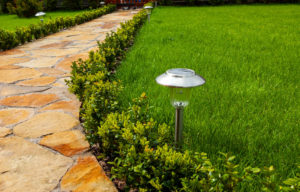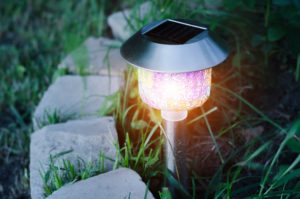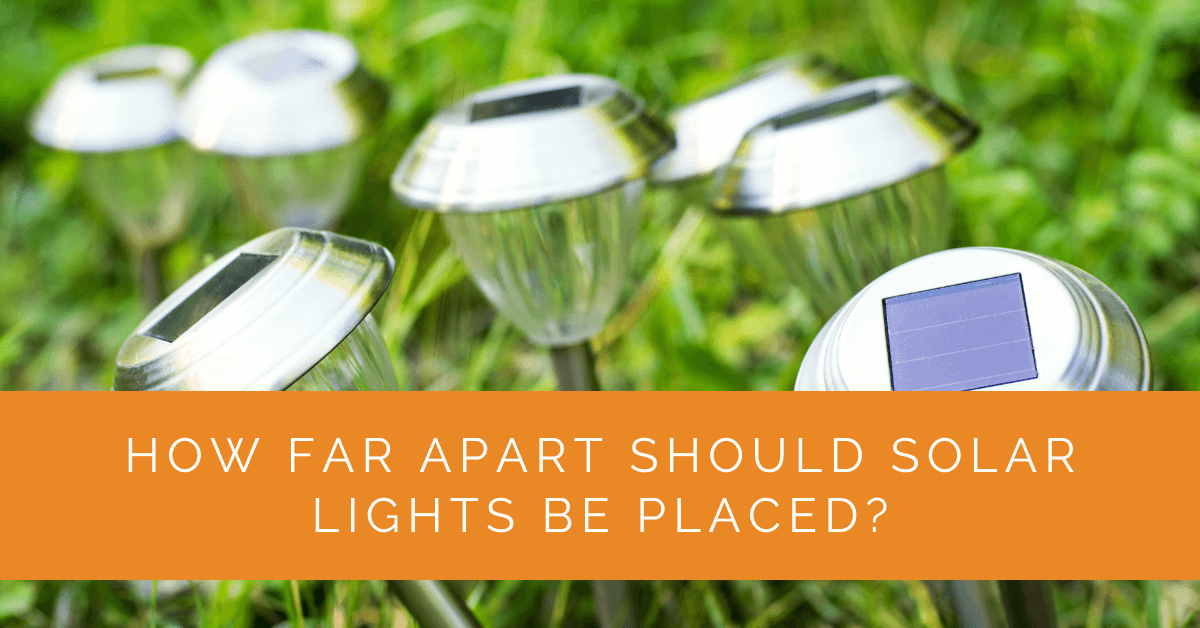Solar lights have become a popular choice for outdoor lighting, offering energy efficiency and easy installation. However, to ensure optimal performance and aesthetics, it’s crucial to determine the appropriate spacing between solar lights. This article explores the factors to consider and provide guidelines for placing solar lights in your outdoor space.
Contents
- 1 Key Takeaways
- 2 Understanding Solar Light Spacing
- 3 Factors to Consider for Solar Light Spacing
- 4 Recommended Spacing Guidelines
- 5 Adjusting Spacing for Optimal Performance
- 6 Maximizing Solar Light Efficiency
- 7 Aesthetic Considerations
- 8 Case Study: Optimizing Solar Light Placement for a Residential Property
- 9 Expert Insights From Our Solar Panel Installers About Solar Light Placement
- 10 Our Expertise in Solar Lights
- 11 Conclusion
Key Takeaways
- The spacing between solar lights is crucial for optimal performance and aesthetics, considering factors such as light intensity, the purpose of the outdoor space, and sun exposure.
- General guidelines suggest placing pathway lights 6-8 feet apart, accent lights 10-15 feet apart, and string lights 2-6 feet apart. However, adjustments should be made based on individual preferences and desired lighting effects.
- Regular assessment, maintenance, and adjustment of solar light spacing are necessary to achieve the desired illumination, maximize energy efficiency, and create a visually pleasing outdoor lighting design.
Understanding Solar Light Spacing
Proper spacing between solar lights is essential for achieving effective illumination and an aesthetically pleasing lighting design. The distance at which you place the lights impacts the coverage area, brightness, and overall visual appeal. To determine the ideal spacing, several factors need to be considered.
Factors to Consider for Solar Light Spacing
- Light Intensity and Spread: Different solar lights have varying intensities and beam angles, affecting light spread. Lights with higher lumen output and wider beam angles will cover a larger area, influencing the spacing between them.
- Purpose of Outdoor Space: Consider the specific purpose of the outdoor area you want to illuminate. Lights should be placed closer together for pathway lighting to ensure adequate visibility. Lights can be spaced farther apart to accentuate a landscape feature to create a subtle silhouette effect.
- Type of Lighting: Different types of solar lights serve different purposes. Pathway lights guide people along walkways, while spotlights highlight specific elements in the landscape. String lights provide a decorative ambiance. The type of lighting you choose will influence the spacing required for optimal performance.
- Sun Exposure and Shading: Solar lights use direct sunlight to charge their batteries. Consider the amount of sunlight the area receives throughout the day and any potential shading from trees, structures, or landscape features. Lights should be placed where they can receive sufficient sunlight for effective charging.

Recommended Spacing Guidelines
While there are no hard and fast rules for solar light spacing, here are some general guidelines to consider:
- Pathway Lighting: Placing lights approximately 6 to 8 feet apart for walkways and pathways ensures a well-illuminated path. Adjust the spacing based on the desired brightness level and the light output of the specific solar lights you’re using.
- Accent Lighting: When accentuating specific landscape features, such as trees or statues, lights can be placed farther apart, typically between 10 to 15 feet. This spacing creates a captivating play of light and shadows, enhancing the visual impact of the highlighted elements.
- String Lights: For decorative string lights, spacing can vary depending on the desired ambiance. Lights can be placed closer, around 2 to 3 feet apart, to create a denser, more vibrant illumination. Alternatively, lights can be spaced around 4 to 6 feet farther apart for a more scattered and enchanting effect.
Remember, these are general recommendations, and you can adjust the spacing based on your preferences and the specific lighting effects you wish to achieve.
Adjusting Spacing for Optimal Performance
While guidelines provide a starting point, it’s crucial to adjust the spacing of solar lights based on the unique characteristics of your outdoor space. Here are some considerations for optimizing performance:
- Brightness and Coverage: If the lights are not adequately illuminating the desired area, you may need to bring them closer together to create a stronger pool of light. Conversely, spacing lights farther apart can help achieve a more balanced and even distribution if the light is too intense or concentrated.
- Homeowner’s Preference: Every homeowner has different preferences regarding brightness, spacing, and visual effects. Experiment with different spacings to find the arrangement that suits your aesthetic vision and lighting goals.
- Mixing Lighting Types: If you’re using multiple types of solar lights, such as pathways and spotlights, it’s important to consider how they complement each other. You may place pathway lights closer together to ensure a well-lit walkway while spacing spotlights farther apart to highlight specific landscape features. Finding the right balance between the two types of lighting will create a cohesive and visually appealing outdoor lighting design.
- Pool of Light: For areas that require a larger pool of light, such as seating areas or gathering spaces, consider placing solar lights closer together. This creates a more concentrated and well-defined illumination area, ensuring a welcoming and cozy ambiance for outdoor activities.
- Uplighting and Downlighting: If you’re using solar lights for uplighting or downlighting effects, such as illuminating trees or architectural elements, adjust the spacing based on the desired intensity and angle of light projection. Placing lights closer together can create a more dramatic and focused effect while spacing them farther apart provides a broader and softer illumination.
Remember, solar lights are powered by the energy they collect during the day, so it’s crucial to position them in areas that receive direct sunlight. Ensure that no obstructions, such as tall plants or structures, can cast shadows and affect the charging efficiency of the solar lights.

Maximizing Solar Light Efficiency
To maximize the efficiency and performance of your solar lights, consider the following tips:
- Proper Installation: Follow the manufacturer’s instructions for installing solar lights correctly. Ensure that they are securely positioned and aligned to receive optimal sunlight exposure.
- Regular Maintenance: Keep the solar panels clean and free from dust, debris, or any obstructions that can hinder sunlight absorption. Regularly check and replace rechargeable batteries as needed to maintain consistent performance.
- Evaluate Lighting Needs: Regularly assess your outdoor lighting requirements. As your landscape or lighting needs evolve, you may need to reevaluate and adjust the spacing of your solar lights to meet new demands.
By implementing these practices, you can maximize the efficiency and longevity of your solar lighting system, ensuring reliable and sustainable outdoor illumination.
Aesthetic Considerations
While functionality is essential, the aesthetic aspect of outdoor lighting should not be overlooked. Consider the visual impact of the spacing between solar lights. Strive for a balanced and visually pleasing arrangement that complements your outdoor space’s architectural features, landscaping elements, and overall ambiance.
Case Study: Optimizing Solar Light Placement for a Residential Property
Background
At Solar Panels Network USA, we are dedicated to helping homeowners achieve optimal performance from their solar lighting systems. This case study outlines our approach to optimizing the placement of solar lights for a residential property, ensuring both functionality and aesthetic appeal.
Project Overview
A client reached out to us with a newly installed solar lighting system that was not performing as expected. The primary issues were uneven lighting and some areas being too dark while others were overly bright. Our goal was to assess the current setup and make necessary adjustments to enhance the overall effectiveness and visual appeal of the solar lights.
Implementation
Initial Assessment
We conducted a thorough site inspection to evaluate the current placement of the solar lights. Key factors considered included:
- Sunlight exposure throughout the day
- The intensity and spread of each light
- The specific purpose of each light (e.g., pathway lighting, accent lighting)
- Any potential obstructions causing shading
Step-by-Step Optimization
- Avoiding Shades: Many lights were placed under trees and near structures that cast significant shadows. We relocated these lights to areas with unobstructed sunlight, ensuring maximum exposure and efficient charging.
- Adjusting Light Spacing: For the pathway lights, we found that placing them approximately 6 to 8 feet apart provided a well-lit walkway without any dark gaps. This spacing ensured continuous illumination, enhancing safety and visibility.
- Optimizing Accent Lighting: The accent lights highlighting trees and garden features were initially too close together, creating overly bright spots and missing the desired subtle effect. We adjusted the spacing to 10 to 15 feet apart, achieving a balanced and captivating play of light and shadows.
- Refining String Light Placement: The decorative string lights were placed too far apart, resulting in a sparse and underwhelming display. We repositioned them closer together, around 3 feet apart, creating a denser and more vibrant illumination that added charm to the outdoor seating area.
- Ensuring Proper Installation: We ensured all lights were securely positioned according to the manufacturer’s guidelines, with panels oriented towards the sun. Proper alignment and secure installation are crucial for maximizing the efficiency and lifespan of solar lights.
- Regular Maintenance: We advised the homeowner on the importance of regular maintenance, including cleaning the solar panels and checking for obstructions. This helps maintain optimal performance and prolongs the life of the solar lights.
Results
After implementing these adjustments, the client’s solar lighting system showed significant improvements:
- Even and continuous illumination along pathways
- Enhanced visual appeal of garden features with well-spaced accent lights
- A charming and vibrant ambiance in the outdoor seating area with optimally placed string lights
- Increased overall efficiency and performance of the solar lights due to improved sunlight exposure
Summary
This case study demonstrates the importance of proper spacing and placement of solar lights for optimal performance and aesthetics. By considering factors such as sunlight exposure, light intensity, and the specific purpose of each light, we were able to significantly improve the effectiveness and visual appeal of the client’s solar lighting system. Regular maintenance and strategic adjustments are essential for maximizing the benefits of solar lights.
At Solar Panels Network USA, we are committed to providing expert advice and solutions to help our clients achieve the best possible outcomes with their solar lighting. Whether it’s for safety, aesthetics, or energy efficiency, we ensure your solar lights are perfectly placed to meet your needs.
Expert Insights From Our Solar Panel Installers About Solar Light Placement
Proper spacing is key to maximizing the efficiency of solar lights. Too close, and you waste resources; too far, and you get dark spots. Understanding light intensity and spread helps achieve perfect placement.
Senior Solar Technician
Considering the purpose of the space is crucial. Pathway lights need closer spacing for safety, while accent lights can be spread further apart to create dramatic effects.
Lead Solar Installer
Sun exposure is vital. Even the best-placed lights won’t perform if they’re in the shade. Ensuring direct sunlight is a fundamental step in solar light placement.
Solar Installation Specialist
Our Expertise in Solar Lights
At Solar Panels Network USA, we’re here to provide you with valuable information and support regarding solar lighting. With our experience and understanding of the solar lighting industry, our team of experts is prepared to assist you in finding the right lighting solution for your needs. Whether you’re interested in improving your outdoor spaces, conserving energy, or adopting a more sustainable approach, we’re well-equipped to help. Please feel free to contact us with any questions or inquiries.
Conclusion
Proper spacing of solar lights is crucial for achieving optimal performance, functionality, and visual appeal. By understanding the factors influencing spacing and following general guidelines, you can create a well-illuminated outdoor space that enhances safety and aesthetics.
Remember to consider factors such as light intensity, the purpose of the space, sun exposure, and shading when determining the ideal spacing between solar lights. Regularly assess and adjust the spacing to optimize performance, maximize energy efficiency, and achieve the desired lighting effects.
Illuminate your outdoor space with solar-powered lights strategically placed and thoughtfully spaced to create a beautiful and inviting atmosphere. Harness the sun’s power, embrace the benefits of outdoor lighting, and transform your outdoor living experience.
About the Author
Solar Panels Network USA stands at the forefront of solar energy solutions, driven by a team of seasoned solar engineers and energy consultants. With over decades of experience in delivering high-quality solar installations and maintenance, we are committed to promoting sustainable energy through customer-centric, tailored solutions. Our articles reflect this commitment, crafted collaboratively by experts to provide accurate, up-to-date insights into solar technology, ensuring our readers are well-informed and empowered in their solar energy decisions.

